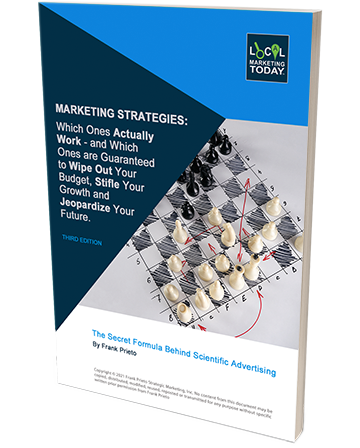1. How to tell if a mailing can work before spending money.
If you want to do direct mail marketing to promote a product or service, it is important to take a few things into consideration before spending money on printing, mailing and postage. Most of us are very passionate about the benefits of our products or services, and sometimes we make the mistake of thinking that the rest of the world will see it the same way. Unfortunately the market has a mind of its own, so it’s a good idea to do a quick and simple screening test before spending your advertising dollars to find out that DMM won’t work for your application.
The key is to figure out what kind of response you need for a success before doing anything else to see if it’s feasible. The easiest way to explain this is with an example:
Suppose you want to sell a book by direct mail to social workers and people in the justice system, which could benefit from the unique experiences that you’ve had in your specialized area of work. Say you want to sell this book for $19.95. Your cost to print it, package it, and ship it is $3.50, which leaves you a gross profit of $16.45, assuming you will charge for shipping and handling to cover postage and fulfillment. Deduct another dollar for the cost to process the orders and your profit is now $15.45.
Assuming a 60 cent cost each for the mailing, your breakeven point is 3.88% (.6/15.45 = .0388). To make any money at all, say just doubling your mailing cost you’d need a 7.76% return which is highly unlikely. Why? Because the national average response rate for direct mail marketing is between 1% and 2%.
These figures could improve considerably if you had other products that you could sell your book customers even if you lost money getting the first sale but not with just one product.
Don’t get me wrong, direct mail marketing is still one of the best ways to get your sales message and product to a buyer. But always remember that marketing is a science, and as a science you’ve got to follow the formula. The key is to figure out what kind of response you need to get so that your mailing makes you money or at least breaks even.
2. How to define your market size and whether you can reach them.
Assuming you’re wanting to sell a product or service by mail, the next step is to make sure your market is big enough and you can identify who you need to mail to.
There is information available on 40,000 direct response lists, and the size of these markets. The first step is to find a list for rent from your competitors. Why? Because if you can’t find anyone selling whatever you want to sell, direct mail may not work for your product.
After you find these lists, look for the “90-day hotline” buyers. “Hotline” means the most recent buyers. So, a 90 day hotline means their customers from the last 90 days. Most lists have this feature because they can charge more for these recent buyers so they segment these out. This tells you how many customers they’ve sold in 90 days, and the average order of these customers.
Now, multiply the average order by the number of customers, and you’ve got their sales for 90 days. Multiply that by four, and you now you have that company’s sales for the year. Now go to the next list and do this again. Once you have gone through all of the lists in your market, add them up, and that’s how big the market is for direct response sales of your product.
If you find that the total market is $100,000, you may want to take another look at your product because it may not be worth it. It is safe to say that you can penetrate 5% of a market but it will take more than one mailing. This would mean $5,000 in sales. Do you want to go through all the expense of developing and testing a mailing just to make $5,000 in sales? It’s better to find a market with a lot of buyers and then develop your product.
Again, the key is to figure out what kind of response you need for a successful outcome before doing anything to see if it’s feasible.
3. Why you need to know the lifetime value of a customer.
The lifetime value of a customer is what an average customer is worth to you over their lifetime as a customer. This is important to know so you can determine what you can afford to pay for a new customer. Understanding this can keep you from making bad marketing decisions. For example, let’s say you did a marketing campaign to get new customers and you made $10,000 in sales from the program but the campaign cost $15,000. Did it work?
It would be easy to conclude that the program was a failure and that is what most people would say. But, what if that $10,000 in sales came from 30 new customers? If your lifetime value of a customer is $3,000, these 30 customers are ultimately worth $90,000 to you for a cost of only $5,000. That’s $166 to get each customer who will be worth $3,000 ($5,000/30=$166.67.)
This is a successful campaign, not a failure.
4. How and why to profile your customers.
Profiling customers means to learn demographic, geographic, and psychographic things about them so you can more effectively find more people or businesses that are like those who have already bought from you.
If you break your customer list down into 10 segments, you’ll probably find that one or two of those have a much higher percent purchase than the other eight or nine, so if you are going to rent a list it makes sense to only rent the segments of the list like your best customers.
There are two types of profiling. One is business-to-consumer (BTC), and the other is business-to business (BTB.)
In BTC profiling the demographics could include age, sex, how may kids, and things like that. You can even do a combination of geographic characteristics and demographics which is called geo-demographics. To make it even more complicated you can add the psychographic lifestyle factors like hobbies and interest factors. Profiling like that which combines all of these things can get expensive, but the more data you can get on your customers, or you have on them the easier it is to sell them with a targeted approach.
In BTB profiling, one of the ways to sort is by SIC codes which gets into specific industry groups. You can add to that the size of the company, the number of employees, the credit rating, metro areas vs. rural areas or many other criteria. One indicator that could be very revealing is dollar sales per employee. To calculate this, divide the company’s revenue by their number of employees. In any given industry, the more revenue they have per employee the more disposable business income they have to spend.
5. What is the difference between a Compiled List and a Response List?
A Compiled List is a mailing list that is compiled from a database like the Yellow Pages.
A mailing list company like Info USA compiles all the Yellow Pages from all over the country into a huge database of about 14 million companies, and many millions of consumers. The business lists are then sorted by location, business type, size, and SIC Code. Consumer lists are sorted by many different criteria including income level based on residence address, whether male/female, black/white, kids/no kids, etc. You can get owners of 57 red Chevys who live in Miami, and even people by their birth dates.
You can find a compiled list for just about anything you could think of, but they are compiled from some database somewhere, and they’re not mail order buyers.
A Response List is a list of people that have responded to some sort of direct marketing approach. They could have responded to a TV ad, a catalog, or a mailing, and made a purchase. These lists are sorted in many different ways. For example, if you want to sell something to people that like to scuba dive you can find a catalog of scuba diving equipment and probably rent that list which has people who have bought what you’re trying to sell.
How do you know which kind of list to use? If you want to sell something through direct mail you are better off using a response list. On the other hand, if you are doing a lead generation mailing you can use either one, but if you are focusing on a narrow target market you will do a lot better with a compiled list. For example, if you want to sell something to doctors in Miami you might find a list of doctors that have bought something by mail, but you might just get 10% of doctors in Miami. With a compiled list you will get all of them. So if you want to generate leads for your sales department you will do best with a compiled list.
6. An example of selling by mail.
Let say you are selling an expensive putter for golfers and you want to sell them by mail. You could get a complied list of sales managers, figuring that sales managers make more than sales people. That maybe sales managers or vice presidents of sales would be a good target because they presumably earn more money. You also figure that most of these sales managers are out playing golf all the time, so they might be great prospects.
Well, that might sound good initially, and if your talking to someone who is trying to sell you a complied list, that might be exactly what they recommend. However, what if you got a list of the subscribers to say Golf magazine. Now you’re not guessing whether they play golf or not. You know that, not only do they play golf, but they also like to play golf enough so that they bought a magazine about playing golf. And they bought the magazine by mail. So that means they are not in the 30% of the people in the US who never buy by mail. So the Golf magazine subscribers list would probably work way way better than the compiled list of sales managers. But let’s take it a step further.
How about if you could find a list or people who bought a golf product by mail from some other company? If you’re selling a golf product by mail and can find a list of people who have already bought a golf product by mail, then that’s even better.
But we can go a step farther then that. How about if they bought a golf product last month? Now you have recent buyers of a golf product and they are even more likely to buy from you.
How about if the product they bought last month cost more than $200? Since your product is $200, if you can find somebody who bought a similar product that cost that much or more, recently, then imagine how much better response you will get form that list compared to your list of sales managers. The difference is huge. You could easily have 10 times the response going from one extreme to the other, which can easily make the difference between your mailing working or not working.
7. How to buy a mailing list.
The first thing to keep in mind is not to trust the rate card that gives you information about the list. A rate card is just a sales document and should not be used to make a decision about whether to rent the list or not. A rate card might state they have 50,000 mail order buyers when in fact they only have 10,000 mail order buyers, and 40,000 who inquired but never bought. So asking the right questions is important like:
What is the size of the list and the cost-per-thousand?
This is important because you need to know how many names are there to roll out to if you do a test and it works. If you have a list of 10,000 names and you’re going to test 5,000, the typical minimum order, your only roll out is the other 5,000 names. Meanwhile a test of 5,000 on a list of 100,000 has a 95,000 name rollout if the test works. All things being equal, the one with the larger rollout potential is the better list.
Is the list related to your offer?
Are the customers on the list you’re renting buying something similar to what you’re selling? Be careful not to sell steaks to vegetarians. Make sure it makes sense.
How recent are the names?
This is called “recency”, meaning how recently these people have bought. This factor is very important.
What did they spend?
Make sure that if you’re trying to sell something you don’t buy a list of contest entrants who didn’t buy anything but are considered a response list because they responded to a direct responses offer.
Are the names buyers or inquirers?
Make sure they really are buyers and not inquirers. Odds are that there are some of each and that’s okay, but you’re definitely going to want to test with the buyers and not the inquirers.
Where did the names come from?
Are the names direct mail generated, or did they come from another source? If the names are not all direct-response generated then the list is not as good.
Are they multi-buyers?
Multiple buyers are people who have bought more than once. If they can be segmented out, then you want to buy the most recent names that bought for the amount you are selling and also bought more than once. Test the multi-buyers first because if the best people you can test don’t work, then the others aren’t going to work either.
Does the list have a high dupe rate with your house list?
If you already have a customer list and you do a merge-purge, which is to combine two lists to see how many duplicates there are, is the amount of duplicates high? You might think this is a bad thing but it’s not, it’s actually a good thing. Why? Because that’s an indication that the list you are renting is the same type of person as your customer list, and that’s a great thing.
Does the list have a history of repeat mailers?
Who are the mailers that have rented this list? Did they test it? And then, did they roll out their test? Did they then do it again? Did they repeat mail?
Do your competitors rent the list?
This is also a good thing. If you competitors have rented the list, and especially if they have rented it more than once, it’s a sign that it works.
If the list is a “buyers” list, how did the people pay?
Did they pay up front with a credit card or was it one of those offers where you pay nothing until next year? Obviously, your better prospects are the people who just put it on a credit card.
When was the last time the list was cleaned?
“Cleaned” means database updating. The statistics are that one-fifth of the population moves each year. This means that if the list is a year old and has not been cleaned, 20% of the addresses will be outdated and undeliverable.
In the case of business addresses, especially with individuals at business addresses, 50% of the list could be obsolete after only a year. That’s not so much the businesses moving, but the people moving.
What formats are available?
There are many different formats for lists. You can get them on disk, adhesive labels, labels without adhesive, and even e-mailed to you as a .csv file for immediate use. One thing to remember if you’re going to do a mail merge is that the list doesn’t come in all caps, the post office approved format for automation mailings. Why? Because if you’re doing mail merge and the persons name is printed in all capital letters in the middle of the letter it will be obvious that it is not a personal letter. You will lose the whole personalization effect.
I hope that you found this information valuable in helping you better understand Direct Mail Marketing. If you need marketing help developing a successful Direct Mail Marketing campaign or creating a Strategic Marketing Program for your business please don’t hesitate to contact me.
Frank Prieto
Marketing Strategist


